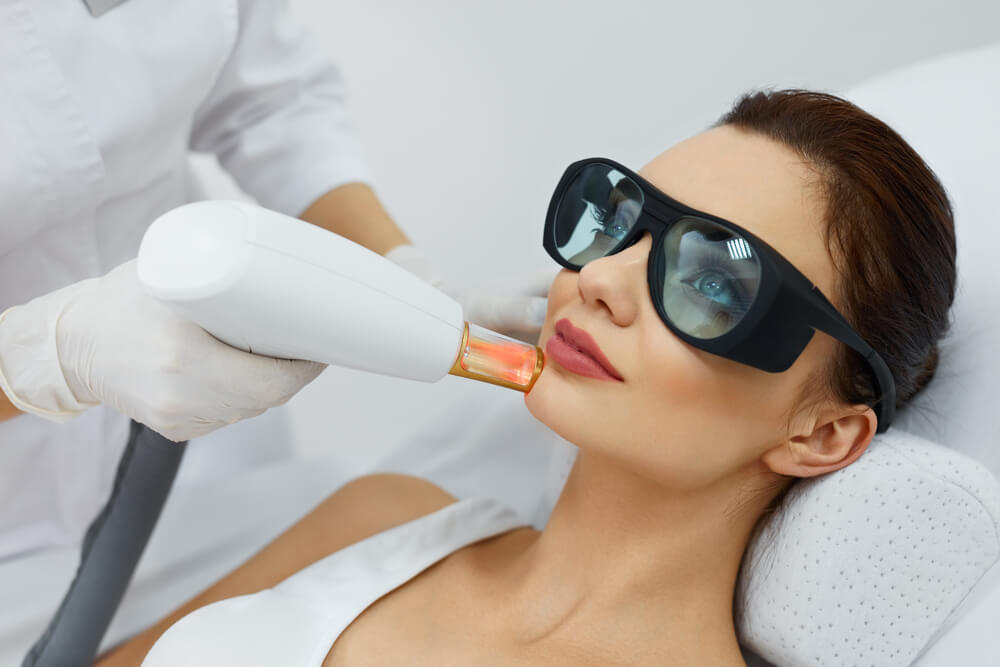When you have wrinkles, sagging skin, acne scarring, or hyperpigmentation, it can be challenging to find an effective solution. Mixing and matching various over-the-counter products can make a slight difference, but there are innovative skin rejuvenation treatments available now that can provide you with excellent results.
If you are curious about laser resurfacing to improve the condition of your skin or boost your confidence, you probably have questions about the procedure, the results, safety, and the upkeep. We’re here to guide you through the top things you should consider when exploring laser skin resurfacing.
- What Is Laser Resurfacing?
Laser skin resurfacing is a term used to describe various procedures that use lasers to improve the texture, color, tone, or appearance of skin. Two types of lasers are used during laser treatments, ablative and non-ablative.
An ablative laser will remove the surface of the skin. This means that the healing period can be longer, but the results are typically much more impressive. Non-ablative lasers penetrate the surface of the skin and focus on the tissue beneath it. These lasers allow for a shorter recovery period and have milder results that are best built over a series of visits.
All types of laser treatments achieve results by encouraging your body’s natural healing processes to activate. When minor injuries happen to your body from heat or the removal of the top layer of skin, it will encourage your body to create new collagen, form new skin, and correct some of the issues you are experiencing.
- What Are the Benefits of Laser Skin Rejuvenation Treatments?

When it comes to high-impact treatments, laser resurfacing stands in a class of its own. It is an excellent choice for people who want significant results, like those from laser scar removal, or who have multiple conditions they want to address with a single treatment, like laser for age spots. Some of the benefits of laser skin resurfacing include:
- Minimized acne scarring or facial scarring
- Reduced hyperpigmentation for a more even skin tone
- Reversal of sun damage
- Removal of fine lines and wrinkles
- Tighter skin on the face
- Reduction of crow’s feet around the eyes
And more!
Skin resurfacing is very effective at improving a broad range of conditions, and you can use it in conjunction with other skin rejuvenation treatments for the best outcome.
- How Much Downtime Do Laser Treatments Require?
When you are planning out your laser scar removal or other treatment, there are a few factors you should consider carefully. Fall and winter are popular times for laser resurfacing, because the treated skin will be more sensitive to sun exposure for the first few months following your procedure.
The pain or discomfort you feel during your laser for wrinkles, or other treatment might vary. Your experience will largely depend on your pain tolerance, the type of laser being used, how deep into your skin the laser is penetrating, and how large of an area is being treated. Ablative lasers that remove the skin’s surface might be more uncomfortable than non-ablative treatments. Ablative procedures also usually require more recovery time.
When you schedule your laser treatments, speak with your doctor to get a more precise idea of what your recovery time might look like. This will allow you to avoid special events or outdoor activities that might compromise your results in the immediate aftermath of your procedure. In general, you should budget up to three weeks for the healing process to complete.
- Who Is a Good Candidate for Laser Skin Resurfacing?
Laser skin rejuvenation treatments can be intensive, which means that every person is not necessarily a perfect candidate. When you are exploring laser scar removal, you should speak with your doctor about any medications you are currently taking, your medical history, and any skin issues that you have now or have had in the past.
For example, if you have a history of cold sores or acne, laser resurfacing might lead to a small breakout as you heal. In other cases, being on blood thinners can accelerate your risk of experiencing bleeding after a procedure. Laser treatments can only be performed on the face, so if the skin issues you are experiencing are elsewhere on your body, other skin rejuvenation treatments might be more appropriate.
Finally, patients with a very deep skin tone can still benefit from laser scar removal, but the laser might lead to scarring or discoloration of the skin. Your scar removal specialist can carefully examine the pigment of your skin to help you make an informed decision about the risks associated with the procedure. There are many alternative treatments to laser resurfacing in Miami, like microneedling, that can give exceptional results with lower risks.
- How Many Laser Procedures Are Needed to Get Results?
No two patients have identical skin issues, so you might require more treatments based on the current condition of your skin, your transformation goals, and the type of lasers used. In some cases, ablative lasers can achieve optimal results in a single session. Generally, non-ablative lasers require a series of three or more treatments to deliver the high-impact results every patient craves.
- How Long Do Results From Laser Procedures Last?
The longevity of your laser skin procedure will vary depending on what is being treated, the type of laser being used, and the number of sessions that you have. Many patients start to notice results immediately and experience improvements in the weeks following their treatment.
After resurfacing, most patients get to enjoy tight, smooth skin for three to five years, providing that they maintain it carefully and wear a strong SPF when outdoors. To extend the longevity of your results, you can visit your doctor once a year for additional treatment. At home, you should hydrate properly, exfoliate regularly, and avoid direct sun exposure without a hat or sunscreen.
- Can You Use Laser Procedures in Conjunction With Other Treatments?

Yes! Laser skin rejuvenation techniques are completely safe and can be combined with other cosmetic treatments to improve your problem areas. For example, if you have volume loss in your face as you age, laser technology can be used alongside a dermal filler to help you look and feel your best again.
Are You Ready to Love the Skin You’re In? Talk to the Team at South Miami OB-GYN Associates
It can be challenging to look in the mirror every day and feel like you aren’t putting your best self forward. Every year, millions of women explore treatments that don’t work or that are highly invasive. South Miami OB-GYN Associates is proud to work with women of every age who want to feel better about their skin and remove the signs of aging, dark spots, stretch marks, and more. Our doctors are skin rejuvenation professionals who can create a customized treatment plan for your needs.
If you are ready to explore lasers to improve your skin or would like to learn more about other cosmetic procedures we offer, South Miami OB-GYN Associates is here for you. Schedule your appointment with our fast online scheduling tool or give us a call at (305) 665-1133. We are here to support you.




